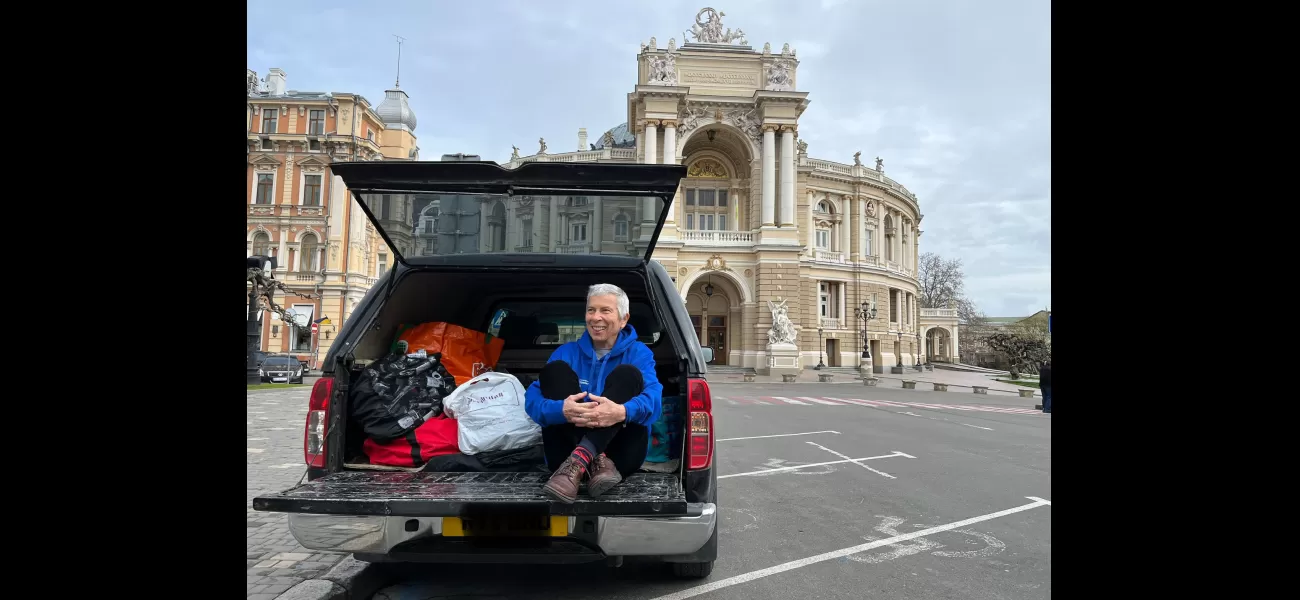Ukraine needs more than weapons to succeed - I can help with that.
I drive donated equipment to Ukraine's frontlines and document my journey through photos.
October 27th 2023.

When Vladimir Putin’s Russia invaded Ukraine in February 2022, I was a long way away, scuba diving in Madagascar. Having decided to stop reporting on conflicts, I was writing a book on Cuba. But when the war broke out next door to my native Poland, I was overwhelmed by the scale of the monstrosity and couldn’t stay away.
Like many of my fellow Poles, I could have focused on helping the refugees and provided teddy bears, Pampers and baby formula to the Ukrainian children fleeing with their mothers across the Polish border. But given the obvious injustice of the full-scale invasion and my own experience as a longtime war correspondent, I decided instead that I wanted to support the Ukrainian army.
I called a historian friend in Odesa and asked what was most needed. He answered with one word: tourniquets. I googled “tourniquets,” found a provider in Warsaw, bought two suitcases worth and flew to Chisinau, Moldova. A border crossing, four hours in a shared taxi and voilà: I was in Odesa with the tourniquets.
Soon, someone needed a driver to cross the border to deliver a car to Ukrainian forces. Then I was asked to carry in a few drones. Next thing I knew, I was acting as an unofficial military procurement officer for units on the front lines.
These days I’m working with my friend Olga Shpak, a marine biologist who in February 2022 was in Moscow working on a conservation plan for bowhead whales for the Russian Academy of Sciences. Two days before the full-scale invasion she left everything behind and made her way back to Ukraine, to her native city of Kharkiv.
Now we work as a team — Olga takes requests from military units and buys provisions on behalf of a U.S.-based NGO called Assist Ukraine, which collects private donations to provide needed aid including medical equipment and nonlethal military gear like helmets and night vision goggles. Myself, I crowdsource what’s needed in Europe or the United States, purchase it and drive it into Ukraine. Often, Olga and I travel to the frontlines to deliver the equipment. Often, the vehicle I drive is a donation, too.
So far, I have bought and delivered seven vehicles to Ukrainian troops and I’m currently collecting money for an eighth — a refrigerator van the 127th brigade requested to evacuate bodies. I have also delivered a dozen Mavic 3 drones that I buy on eBay, and close to 6,000 tourniquets, first purchased in the U.S. for $25 each and brought to Warsaw by business-class traveling friends with generous luggage allowances. Now I buy tourniquets from a local Ukrainian manufacturer for $13 each.
This is a totally informal delivery network, which tries to plug the gaps in what the Ukrainian military is able to supply. We take a lot of photos on our trips, in part because we use photos and short videos to document the supplies we purchase with donors’ funds in order to show that they were delivered.
My journeys often cover thousands of miles. This particular car delivery required driving 2,026 miles from Bristol, U.K., to Zolochiv in the Kharkiv region; Olga joined me for the Ukrainian part of the journey. We were stopped by Ukrainian police a few times but the car’s registration showing that the end user was a military unit meant the police let us go with a paternal “be careful” rather than a fine for speeding.
The first three cars I drove to Ukraine were bought in Poland, but the war has drained the Polish market of good, used vehicles. Luckily, new British anti-diesel regulations have meant that many U.K. car owners are selling their polluting vehicles, so prices are down. Luckily, too, Ukrainians prefer diesel. This photo was taken last April in my backyard in Warsaw when we were loading up a Nissan SUV I bought in Bristol, U.K., that was destined for the frontlines near Bakhmut — all the bags are filled with tourniquets; the suitcase on the right contains four drones.
Another item in demand on the frontlines are masking ghillies, camouflage nets woven by Ukrainian civilians; they come in different colors depending on the season. When used to disguise vehicles they resemble a huge knitted pullover. On a mildly noisy day near the front lines in Kramatorsk, Olga and I drove into territory with only soldiers in uniform, no civilians to be seen. We brought them a few big balls of ghillies in autumn colors for the soldiers to cover their vehicles or themselves, along with thermal underwear and a gas heater for the cold nights approaching.
I hate these staged “here I am handing over a box of tourniquets” pictures, but my U.K.-based friends tell me that donors like to see the concrete result of their contribution, so we always make a “thank you video,” like this one, and put it on YouTube.
Night vision equipment is also in high demand on the frontlines. The top photo was taken with a white phosphor monocular from an Arizona-based company which I tested in my bathroom with the lights off. I bought it for $2,750 in Poland. The bottom left photo was taken with a thermal monocular — to check the battery I looked at my friend’s car with still-warm tires — which cost $2,415 and was purchased at a store called “Cheap Hunting,” also in Poland. They both traveled with me to Ukraine and are now on the Zaporizhzhia frontline, in the hands of soldiers who are friends-of-friends. The bag at bottom right contains more of the medical supplies in high demand, in this case, burn dressings.
When the war broke out in Ukraine, I knew I had to do something to help. I had the experience of a longtime war correspondent and the passion of a native Pole to support the Ukrainian army. I called a historian friend in Odesa and asked what was most needed. He said “tourniquets” and so I found a provider in Warsaw, bought two suitcases worth and flew to Chisinau, Moldova.
Now I work as a team with my friend Olga Shpak. We take requests from military units and buy provisions on behalf of a U.S.-based NGO called Assist Ukraine. We crowdsource what’s needed in Europe or the United States, purchase it and drive it into Ukraine. We take a lot of photos and short videos to document the supplies we purchase with donors’ funds in order to show that they were delivered.
My journeys often cover thousands of miles. For example, one car delivery required driving 2,026 miles from Bristol, U.K., to Zolochiv in the Kharkiv region. We were stopped by Ukrainian police a few times, but the car’s registration showing that the end user was a military unit meant the police let us go with a paternal “be careful” rather than a fine for speeding.
The first three cars I drove to Ukraine were bought in Poland, but the war has drained the Polish market of good, used vehicles. Luckily, new British anti-diesel regulations have meant that many U.K. car owners are selling their polluting vehicles, so prices are down. My U.K.-based friends tell me that donors like to see the concrete result of their contribution, so we always make a “thank you video,” like this one, and put it on YouTube.
Night vision equipment is also in high demand on the frontlines. The top photo was taken with a white phosphor monocular from an Arizona-based company which I tested in my bathroom with the lights off. I bought it for $2,750 in Poland. The bottom left photo was taken with a thermal monocular — to check the battery I looked at my friend’s car with still-warm tires — which cost $2,415 and was purchased at a store called “Cheap Hunting,” also in Poland. They both traveled with me to Ukraine and are now on the Zaporizhzhia frontline, in the hands of soldiers who are friends-of-friends.
Another item in demand on the frontlines are masking ghillies, camouflage nets woven by Ukrainian civilians; they come in different colors depending on the season. When used to disguise vehicles they resemble a huge knitted pullover. On a mildly noisy day near the front lines in Kramatorsk, Olga and I drove into territory with only soldiers in uniform, no civilians to be seen. We brought them a few big balls of ghillies in autumn colors for the soldiers to cover their vehicles or themselves, along with thermal underwear and a gas heater for the cold nights approaching.
This is a totally informal delivery network which tries to plug the gaps in what the Ukrainian military is able to supply. We are making a difference and I am proud of my contribution to helping the Ukrainian people fight for justice in the face of a full-scale invasion.
When Vladimir Putin's Russia invaded Ukraine in February 2022, I was a world away, exploring the ocean depths in Madagascar. I had decided to take a break from reporting on conflicts and was instead writing a book on Cuba. But when war broke out next door to my native Poland, I felt a responsibility to help out.
Many Poles were focused on providing aid to refugees, and I had the urge to do something similar - but I had also seen the injustice of the full-scale invasion. So I decided to do something different to help the Ukrainian army.
I reached out to a historian friend in Odesa and asked him what was most needed. His answer was simple: tourniquets. After a quick Google search, I found a provider in Warsaw and bought two suitcases worth. Then, I flew to Chisinau and made my way to Odesa with the tourniquets.
Soon, I was asked to do more. Someone needed a driver to cross the border and deliver a car to Ukrainian forces, so I volunteered. This led to me being asked to carry in a few drones, and before I knew it, I found myself acting as an unofficial military procurement officer.
At the same time, my friend Olga Shpak was also making an impact. She had been in Moscow working on a conservation plan for bowhead whales for the Russian Academy of Sciences, but when war broke out two days before the full-scale invasion, she left everything behind and made her way back to her native city of Kharkiv.
Olga and I now work together. She takes requests from military units and buys provisions on behalf of a U.S.-based NGO called Assist Ukraine, which collects private donations. I crowdsource what’s needed in Europe or the United States, purchase it, and drive it into Ukraine. We also often travel to the frontlines to deliver the equipment.
So far, I have bought and delivered seven vehicles to Ukrainian troops and I’m currently collecting money for an eighth. I have also delivered a dozen Mavic 3 drones, as well as close to 6,000 tourniquets. We take a lot of photos to document the supplies and show that they have been delivered.
Our journeys often cover long distances. For example, I drove 2,026 miles from Bristol, U.K. to Zolochiv in the Kharkiv region. Along the way, Olga and I were stopped by Ukrainian police a few times, but they let us go with just a warning.
In addition to vehicles, we also deliver items like masking ghillies, camouflage nets woven by Ukrainian civilians. On a recent trip to the frontlines in Kramatorsk, we brought them a few big balls of ghillies in autumn colors, along with thermal underwear and a gas heater.
Night vision equipment is also in high demand. I bought two monoculars - one white phosphor and one thermal - in Poland, and they both traveled with me to Ukraine. They are now on the Zaporizhzhia frontline, in the hands of soldiers who are friends-of-friends.
I hate taking pictures of myself handing over boxes of tourniquets, but my U.K.-based friends tell me that donors like to see the concrete result of their contribution. So we always make a “thank you video” and post it on YouTube.
No matter what we deliver, it's all part of an informal delivery network that tries to plug the gaps in what the Ukrainian military is able to supply. It's a great feeling knowing that we're making a real difference in the lives of those on the frontlines.
Like many of my fellow Poles, I could have focused on helping the refugees and provided teddy bears, Pampers and baby formula to the Ukrainian children fleeing with their mothers across the Polish border. But given the obvious injustice of the full-scale invasion and my own experience as a longtime war correspondent, I decided instead that I wanted to support the Ukrainian army.
I called a historian friend in Odesa and asked what was most needed. He answered with one word: tourniquets. I googled “tourniquets,” found a provider in Warsaw, bought two suitcases worth and flew to Chisinau, Moldova. A border crossing, four hours in a shared taxi and voilà: I was in Odesa with the tourniquets.
Soon, someone needed a driver to cross the border to deliver a car to Ukrainian forces. Then I was asked to carry in a few drones. Next thing I knew, I was acting as an unofficial military procurement officer for units on the front lines.
These days I’m working with my friend Olga Shpak, a marine biologist who in February 2022 was in Moscow working on a conservation plan for bowhead whales for the Russian Academy of Sciences. Two days before the full-scale invasion she left everything behind and made her way back to Ukraine, to her native city of Kharkiv.
Now we work as a team — Olga takes requests from military units and buys provisions on behalf of a U.S.-based NGO called Assist Ukraine, which collects private donations to provide needed aid including medical equipment and nonlethal military gear like helmets and night vision goggles. Myself, I crowdsource what’s needed in Europe or the United States, purchase it and drive it into Ukraine. Often, Olga and I travel to the frontlines to deliver the equipment. Often, the vehicle I drive is a donation, too.
So far, I have bought and delivered seven vehicles to Ukrainian troops and I’m currently collecting money for an eighth — a refrigerator van the 127th brigade requested to evacuate bodies. I have also delivered a dozen Mavic 3 drones that I buy on eBay, and close to 6,000 tourniquets, first purchased in the U.S. for $25 each and brought to Warsaw by business-class traveling friends with generous luggage allowances. Now I buy tourniquets from a local Ukrainian manufacturer for $13 each.
This is a totally informal delivery network, which tries to plug the gaps in what the Ukrainian military is able to supply. We take a lot of photos on our trips, in part because we use photos and short videos to document the supplies we purchase with donors’ funds in order to show that they were delivered.
My journeys often cover thousands of miles. This particular car delivery required driving 2,026 miles from Bristol, U.K., to Zolochiv in the Kharkiv region; Olga joined me for the Ukrainian part of the journey. We were stopped by Ukrainian police a few times but the car’s registration showing that the end user was a military unit meant the police let us go with a paternal “be careful” rather than a fine for speeding.
The first three cars I drove to Ukraine were bought in Poland, but the war has drained the Polish market of good, used vehicles. Luckily, new British anti-diesel regulations have meant that many U.K. car owners are selling their polluting vehicles, so prices are down. Luckily, too, Ukrainians prefer diesel. This photo was taken last April in my backyard in Warsaw when we were loading up a Nissan SUV I bought in Bristol, U.K., that was destined for the frontlines near Bakhmut — all the bags are filled with tourniquets; the suitcase on the right contains four drones.
Another item in demand on the frontlines are masking ghillies, camouflage nets woven by Ukrainian civilians; they come in different colors depending on the season. When used to disguise vehicles they resemble a huge knitted pullover. On a mildly noisy day near the front lines in Kramatorsk, Olga and I drove into territory with only soldiers in uniform, no civilians to be seen. We brought them a few big balls of ghillies in autumn colors for the soldiers to cover their vehicles or themselves, along with thermal underwear and a gas heater for the cold nights approaching.
I hate these staged “here I am handing over a box of tourniquets” pictures, but my U.K.-based friends tell me that donors like to see the concrete result of their contribution, so we always make a “thank you video,” like this one, and put it on YouTube.
Night vision equipment is also in high demand on the frontlines. The top photo was taken with a white phosphor monocular from an Arizona-based company which I tested in my bathroom with the lights off. I bought it for $2,750 in Poland. The bottom left photo was taken with a thermal monocular — to check the battery I looked at my friend’s car with still-warm tires — which cost $2,415 and was purchased at a store called “Cheap Hunting,” also in Poland. They both traveled with me to Ukraine and are now on the Zaporizhzhia frontline, in the hands of soldiers who are friends-of-friends. The bag at bottom right contains more of the medical supplies in high demand, in this case, burn dressings.
When the war broke out in Ukraine, I knew I had to do something to help. I had the experience of a longtime war correspondent and the passion of a native Pole to support the Ukrainian army. I called a historian friend in Odesa and asked what was most needed. He said “tourniquets” and so I found a provider in Warsaw, bought two suitcases worth and flew to Chisinau, Moldova.
Now I work as a team with my friend Olga Shpak. We take requests from military units and buy provisions on behalf of a U.S.-based NGO called Assist Ukraine. We crowdsource what’s needed in Europe or the United States, purchase it and drive it into Ukraine. We take a lot of photos and short videos to document the supplies we purchase with donors’ funds in order to show that they were delivered.
My journeys often cover thousands of miles. For example, one car delivery required driving 2,026 miles from Bristol, U.K., to Zolochiv in the Kharkiv region. We were stopped by Ukrainian police a few times, but the car’s registration showing that the end user was a military unit meant the police let us go with a paternal “be careful” rather than a fine for speeding.
The first three cars I drove to Ukraine were bought in Poland, but the war has drained the Polish market of good, used vehicles. Luckily, new British anti-diesel regulations have meant that many U.K. car owners are selling their polluting vehicles, so prices are down. My U.K.-based friends tell me that donors like to see the concrete result of their contribution, so we always make a “thank you video,” like this one, and put it on YouTube.
Night vision equipment is also in high demand on the frontlines. The top photo was taken with a white phosphor monocular from an Arizona-based company which I tested in my bathroom with the lights off. I bought it for $2,750 in Poland. The bottom left photo was taken with a thermal monocular — to check the battery I looked at my friend’s car with still-warm tires — which cost $2,415 and was purchased at a store called “Cheap Hunting,” also in Poland. They both traveled with me to Ukraine and are now on the Zaporizhzhia frontline, in the hands of soldiers who are friends-of-friends.
Another item in demand on the frontlines are masking ghillies, camouflage nets woven by Ukrainian civilians; they come in different colors depending on the season. When used to disguise vehicles they resemble a huge knitted pullover. On a mildly noisy day near the front lines in Kramatorsk, Olga and I drove into territory with only soldiers in uniform, no civilians to be seen. We brought them a few big balls of ghillies in autumn colors for the soldiers to cover their vehicles or themselves, along with thermal underwear and a gas heater for the cold nights approaching.
This is a totally informal delivery network which tries to plug the gaps in what the Ukrainian military is able to supply. We are making a difference and I am proud of my contribution to helping the Ukrainian people fight for justice in the face of a full-scale invasion.
When Vladimir Putin's Russia invaded Ukraine in February 2022, I was a world away, exploring the ocean depths in Madagascar. I had decided to take a break from reporting on conflicts and was instead writing a book on Cuba. But when war broke out next door to my native Poland, I felt a responsibility to help out.
Many Poles were focused on providing aid to refugees, and I had the urge to do something similar - but I had also seen the injustice of the full-scale invasion. So I decided to do something different to help the Ukrainian army.
I reached out to a historian friend in Odesa and asked him what was most needed. His answer was simple: tourniquets. After a quick Google search, I found a provider in Warsaw and bought two suitcases worth. Then, I flew to Chisinau and made my way to Odesa with the tourniquets.
Soon, I was asked to do more. Someone needed a driver to cross the border and deliver a car to Ukrainian forces, so I volunteered. This led to me being asked to carry in a few drones, and before I knew it, I found myself acting as an unofficial military procurement officer.
At the same time, my friend Olga Shpak was also making an impact. She had been in Moscow working on a conservation plan for bowhead whales for the Russian Academy of Sciences, but when war broke out two days before the full-scale invasion, she left everything behind and made her way back to her native city of Kharkiv.
Olga and I now work together. She takes requests from military units and buys provisions on behalf of a U.S.-based NGO called Assist Ukraine, which collects private donations. I crowdsource what’s needed in Europe or the United States, purchase it, and drive it into Ukraine. We also often travel to the frontlines to deliver the equipment.
So far, I have bought and delivered seven vehicles to Ukrainian troops and I’m currently collecting money for an eighth. I have also delivered a dozen Mavic 3 drones, as well as close to 6,000 tourniquets. We take a lot of photos to document the supplies and show that they have been delivered.
Our journeys often cover long distances. For example, I drove 2,026 miles from Bristol, U.K. to Zolochiv in the Kharkiv region. Along the way, Olga and I were stopped by Ukrainian police a few times, but they let us go with just a warning.
In addition to vehicles, we also deliver items like masking ghillies, camouflage nets woven by Ukrainian civilians. On a recent trip to the frontlines in Kramatorsk, we brought them a few big balls of ghillies in autumn colors, along with thermal underwear and a gas heater.
Night vision equipment is also in high demand. I bought two monoculars - one white phosphor and one thermal - in Poland, and they both traveled with me to Ukraine. They are now on the Zaporizhzhia frontline, in the hands of soldiers who are friends-of-friends.
I hate taking pictures of myself handing over boxes of tourniquets, but my U.K.-based friends tell me that donors like to see the concrete result of their contribution. So we always make a “thank you video” and post it on YouTube.
No matter what we deliver, it's all part of an informal delivery network that tries to plug the gaps in what the Ukrainian military is able to supply. It's a great feeling knowing that we're making a real difference in the lives of those on the frontlines.
[This article has been trending online recently and has been generated with AI. Your feed is customized.]
[Generative AI is experimental.]
0
0
Submit Comment





